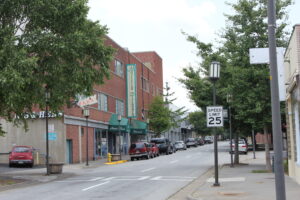When most people living in the West Piedmont Region think of local travel for work or to other destinations, they likely think of getting into the car and driving. And in many cases, driving is the most practical way to reach these destinations. As I had noted in some of my recent blogs, many destinations in the region are accessible by bicycle, particularly for those intent on cycling as part of a New Year’s resolution, or at least a resolution to contribute to a more healthy lifestyle. There are opportunities to walk in the region as well to commute or reach other non-work destinations, though the emphasis for this important activity is in and around the region’s cities and towns.
Why walk? Well, this pre-historic form of transportation is absolutely free, has zero environmental impact, and offers many health benefits. So if you’re looking to improve your health and save money and wear-and-tear on your vehicle, with the added bonus of mitigating environmental impacts, you may want to try walking, particularly as we head into spring with its warmer days.
What are some health benefits of walking? According to America Walks, a non-profit which promotes walking and walkable environments, walking helps to reduce the risk of developing cardiovascular disease and mitigates a number of other conditions including high blood pressure and the effects of arthritis; it can also help manage weight and can address a variety of other conditions. The organization also notes that walking can help to improve the often-overlooked mental health conditions of depression and anxiety.

Source: U.S. Centers for Disease Control and Prevention, Morbidity and Mortality Weekly Report (MMWR). “Trends in Meeting Physical Activity Guidelines Among Urban and Rural Dwelling Adults – United States, 2008 – 2017.” June 14, 2019.
Our region, like many across the U.S., is confronted with a number of health conditions amongst its population. According to Robert Wood Johnson County Health Rankings and Roadmaps, which annually ranks counties throughout the U.S. based on a variety of health indicators, several communities in the West Piedmont Planning District ranked worse than the state average for obesity, which, for Virginia, was 30 percent in 2020. Furthermore, the Region as a whole ranked worse than the state in terms of diabetes prevalence, which was 11 percent for Virginia. Lastly, the Region scored worse than the state in terms of poor mental health days per month which, for the state, averaged 3.8.
So how much physical activity should we get? According to America Walks, children (between ages 3 and 17) should be getting at least one hour per day. Adults, on the other hand, are recommended to get at least 2 hours and 30 minutes of moderate to intense physical activity per week.
Where to Walk
While most of the West Piedmont Region is rural or suburban in character, there is a plethora of opportunities for walking, particularly in the region’s towns and cities. If you work, do business, or shop in mid-town areas such as uptown Martinsville, Danville’s River District, downtown Rocky Mount, Stuart, Chatham, or Gretna, and you live within close proximity to those areas, it would be beneficial to walk, particularly if you live within one-half mile of these areas. What’s more, all of the town and city centers mentioned here, and many of the residential streets that immediately surround them, are served by sidewalks, making walking very feasible and safe in these areas.

Danville’s River District, with its former tobacco warehouses converted to living spaces and its bustling Main Street, is a walker’s paradise!

Uptown and Downtown Rocky Mount, with the Harvester Performance Center, Franklin Center, Carilion Franklin Memorial Hospital, Farmers’ Market and local establishments, is a great place to walk to access work, entertainment, and dining.

Stuart is a great place to walk to access local shopping and dining establishments.

Whether it’s walking to work, to access local dining establishments, the farmers’ market, or to experience history at the Virginia Museum of Natural History or the historic Henry County Courthouse, uptown Martinsville is very walkable.
If you currently walk to get to work, shopping, or other destinations in the West Piedmont Planning District, or if you are planning to start walking more to maintain or improve your health, save money, or are motivated to improve the environment, don’t forget that you will earn points toward rewards each time you log your walk trips into the RIDE Solutions app, which you can download for FREE at ridesolutions.org!


